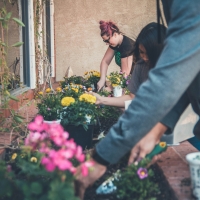Fundraising in this new world is about innovation. Developing something new is fun but also gains attention both on social media and attracts new audiences. How then to best develop new ideas?
Experts tell us it’s not best done by one person sitting at their desk demanding their brain ‘to be creative’ but by a group electrifying each other’s little grey cells. It’s about group brainstorming. Here we lay out some key principles to make the brainstorming process fun, enjoyable and most-importantly, successful.
The team
The first rule of a great brainstorming session is to invite a diverse group of team members with varying experience levels. With a smaller group you will save time on briefing and everyone involved will work to bring their best ideas to the table. Think about who should chair the meeting - someone with an open mind, respected by all.
Preparation
As with every campaign, it's important that everyone is aligned in terms of the main aims and who the audiences are. Before you meet, ensure the team is briefed on the overall requirement. If there are specific needs, ensure these are included. Ideally avoid constraints - we want to encourage free-flowing ideas and only add constraints once the germ of an idea is formed. Once the group knows the key information, they can start thinking individually before the meeting.
Warming up and ground rules
Plan a brain warm-up exercise to get your group relaxed and enjoying themselves. We like posing a ridiculous problem and creating fun ways to solve it e.g. “how to move the meeting room chair to the other wall without touching it.” Run this for three to five minutes. If there are quieter people in the room, suggest team working.
Once everyone is warmed up, explain the ground rules. Most importantly, all ideas are valid at the first stage - whacky, controversial ideas can often stimulate the eventual leading idea. Ideas should not be judged but accepted as given.
Reprise
Reprise the requirement - keep it brief. You’re only ensuring everyone is on the same page.
Ask everyone to note down their ideas
Once you’ve reprised the brief, get going. It's a good idea to have everyone involved to note down their initial thoughts and ideas but this needs to be a short-fire round; a maximum of two minutes. This ensures that ideas aren’t influenced by larger thoughts or personalities. It also means that everyone is engaged and involved.
Capture all the ideas
Use a whiteboard / flip chart (we prefer avoiding a keyboard for this part as we find it can demand correctness of spelling and clarity when you’re mainly looking for creativity). Ask someone to be a scribe and write down ideas as they are given. Avoid commentary from others, just write, write, write. This session should take a maximum of 10 minutes.
Open it up
Now seek input / expansion / questioning of the ideas but again, as moderator, stop any dismissive comments and keep the conversation fluid. Avoid rabbit-holes, seek clarification but keep away from too much detail. Keep things moving.
For a successful fundraising campaign, you need to home in on a winning idea that you can focus on and further develop. One contributed idea might stand out but if not, try the following techniques to now bring focus to the task.
Mind mapping
Take the top three ideas and split the group into sub-groups of two or three; get mind mapping. Put each idea in the middle of a piece of paper and ask a sub-group to start drawing it out. What stages does it have, what does the idea need to be successful, how will it be promoted, can success be measured, which partners can be used to amplify it, what concerns need addressing?
Reverse brainstorming
For charities, it's sometimes easier to see the problems over the solutions. Once you delve into the problems, it can make it easier to develop solutions and ideas that can really drive awareness of your cause. So… introduce reverse brainstorming, which is where you brainstorm the issues that need addressing and then go from there.
Whilst it is easy to host a virtual brainstorm (using Zoom, Teams, GoogleMeet etc.), physical brainstorms in a socially distanced space can really help bounce ideas around. Food and coffee help too!
The more engaging the idea, the more successful it will be. As things have gone virtual, including the London Marathon, it might be worth introducing new digital fundraising methods to boost donations with ease.
Virtual festivals and sponsored events are also great examples of successful fundraising and are easy to set up and can easily be promoted across your channels.
The National Funding Scheme, DONATE offers charities and charitable organisations the opportunity to fundraise via web and text giving, and also through online auctions which has seen a huge surge in interest over the last few months as more charities take their fundraising online and focus on engaging ways to keep their audience engaged, whilst catching the eye of new audiences and donors. For more information visit their LinkedIn page.





